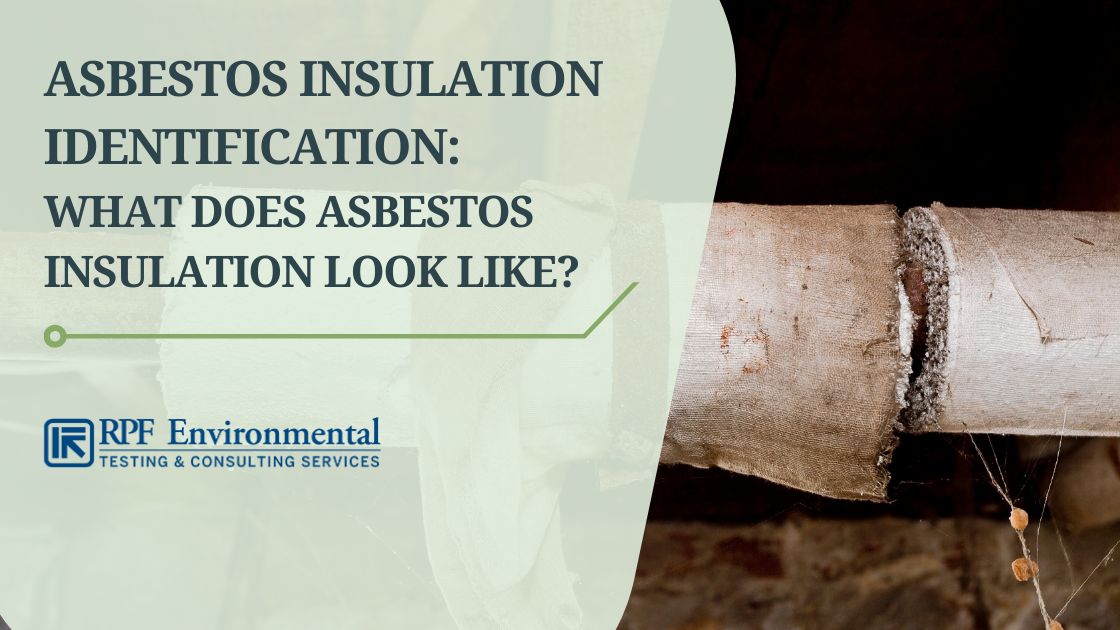If you are a homeowner or business owner who is planning to buy a property or do a major renovation project but is worried about asbestos contamination, welcome! Here, you will learn how to identify old asbestos insulation, its types (including asbestos insulation pipes), and how to handle and remove them safely.

RPF Environmental has certified asbestos inspectors that conduct professional asbestos surveys and testing services in Illinois, Indiana, Maine, Massachusetts, New Hampshire, and other areas throughout the US. Contact us now for affordable and reliable environmental consulting and testing services!
What Is Asbestos Insulation?
Asbestos insulation refers to insulation materials containing asbestos. It is a highly toxic material that was manufactured from the 1860s up to the 1980s. Due to the high resistance of asbestos to fire and corrosion, it was used to reinforce many types of building materials, like insulation, for decades.
Asbestos & Vermiculite Insulation
In addition to asbestos insulation, vermiculite is another fire-resistant mineral that has been used for attic and wall insulation before it was discovered that it was contaminated with asbestos.
More than 70% of vermiculite in the U.S. came from a mine nearby Libby Montana which contained asbestos deposits. Thus, contaminating the vermiculite which was used in home insulations often sold under the brand Zonolite until 1990 when the mine closed. So if your home has vermiculite insulation, there is a high chance that it contains asbestos and you should be careful when handling and removing it.
NOTE: Although the chance of vermiculite insulation being present in homes built after the 1990s is reduced, it is not eliminated.
Where Can You Find Asbestos Insulation in Your Home?
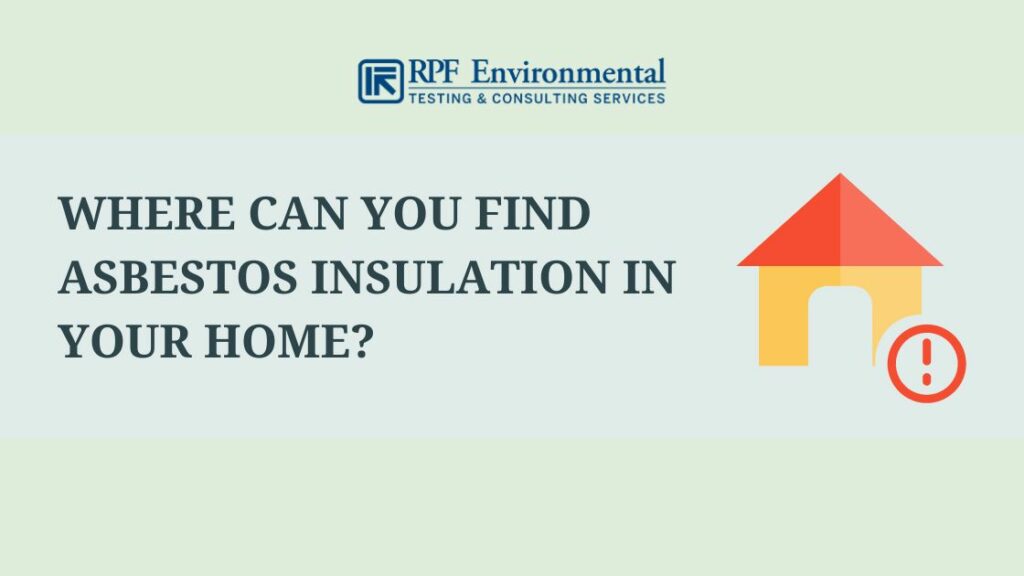
You could find asbestos insulation in almost any insulated area in your home. These include the following:
- Boilers
- Valves
- Steam pipes
- Furnace ducts
- Wall insulation (especially in the basement or attic)
- Floor insulation
- Ceilings
- Structural beams
- Paper, millboard, and cement sheet insulation used around wood stoves and furnaces
- Door gaskets in coal stoves, wood stoves, & furnaces
You can also find asbestos in other areas in your home like floor tiles, spray-on decorative or soundproofing materials, roofing, siding, shingles, and more. Moreover, asbestos insulation was common in plants and factories as well as for military use (shipyards, barracks, aircraft) in the U.S.
Notable Asbestos Insulation Brands and Manufacturers
Among the notable asbestos insulation brands were:
- Zonolite (W.R. Grace)
- Kaylo & Limpet (Armstrong Contracting and Supply)
- Unibestos (Pittsburgh Corning)
- Asbestosfluf (Mr. Fluffy)
- Careytemp (Celotex)
- Hy-Temp (Nicolet)
Other popular asbestos insulation manufacturers in the U.S. include the following:
- A.P. Green Industries
- C.E. Thurston & Sons
- Crown Cork and Seal
- Combustion Engineering
- CertainTeed Corporation
- EaglePicher
- GAF Corporation
- Ehret Magnesia
- Johns Manville
- Keasbey & Mattison
- Kaiser Aluminum
- National Gypsum
- Owens-Illinois
- Owens Corning
- Pacor Incorporated
- Rock Wool Manufacturing
- Shook & Fletcher
- The Flintkote Company
- Unarco
- Western MacArthur
These products usually contain 15% to 100% asbestos.
Types of Asbestos Insulation
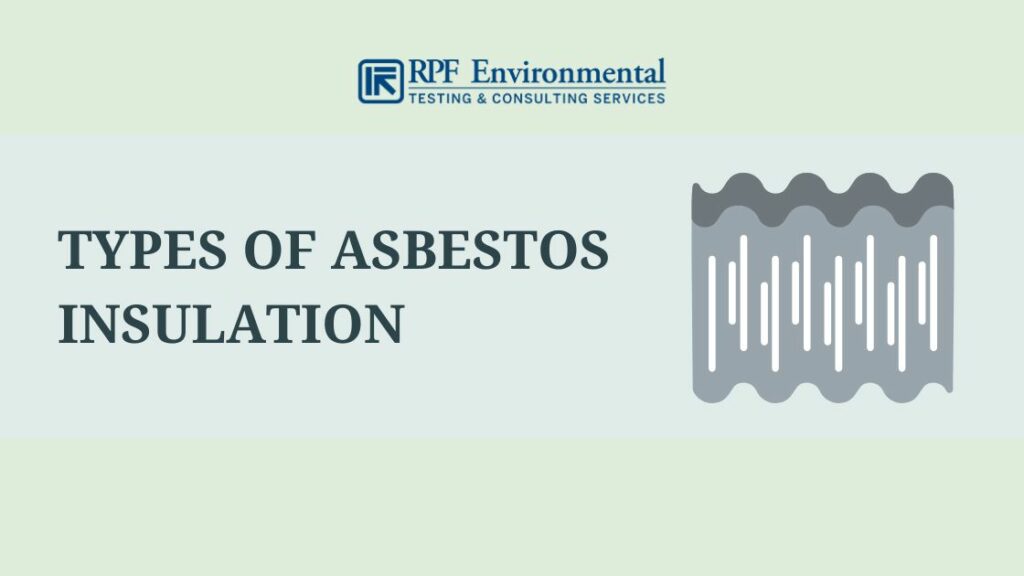
There are four major types of insulation that may contain asbestos:
#1 Spray-On Asbestos Insulation
Usage: Walls, Ceilings, Hard-to-reach areas, Irregular surfaces such as steel beams
Appearance: Often thick gray coating on ceilings in commercial buildings
Risk: Easily damaged and should be thoroughly encapsulated
Other Things to Note: Most spray-on asbestos insulation contains 80% to 85% asbestos
Spray-on asbestos insulation was used in many commercial buildings to make fireproofing and applying insulation to walls, ceilings, and beams easier. It is sprayed as a liquid and can also be used in hard-to-reach areas where it expands to fill gaps.
#2 Loose-Fill Asbestos Insulation
Usage: Attics, Walls, Floors
Appearance: Fluffy, loose, and lumpy form with a granular texture
Risk: Extremely dangerous and can be disturbed by slight air currents
Other Things to Note: Also known as “asbestos attic insulation”
Loose-fill asbestos insulations are poured onto attic flooring and blown into wall cavities and other structures. They can come in many forms, but they are often identified by their fluffy texture.
#3 Blanket/Wrapped Asbestos Insulation
Usage: Pipes, Ducts, Plumbing, HVAC components
Appearance: Can come in large rolls or batts that look like flexible cotton-like blankets, often comes as air-cell insulation
Risk: Friable and crumbles with time and releases large amounts of asbestos fiber once damaged or disturbed
Other Things to Note: Also called asbestos insulation wrapping
Wrapped asbestos insulation was often used as a pipe covering or wrapping in heating and water pipes, especially in Navy ships, factories, oil refineries, and power plants. The pipes were wrapped with air-cell insulation made from asbestos paper before the 1980s. In homes, wrapped asbestos insulation can also be found in walls and attics aside from around pipes.
Asbestos Pipe Insulation
Asbestos pipe insulation typically looks like a white-gray corrugated cardboard/paper with multiple layers. Aside from being wrapped around pipes, asbestos plaster or paste was also used in wrapping piping parts like elbows and valves.
#4 Asbestos Block Insulation
Usage: Walls, Steel structures
Appearance: Rigid insulation slabs that look like boards
Risk: Often made using almost pure asbestos and is extremely dangerous when the slabs/blocks are damaged or sawed
Other Things to Note: Also called asbestos wall insulation
Asbestos block insulation was bought in bulk and then cut and glued into walls for easy insulation. They were popularly used in foundation walls as well as steel structures, especially in shipbuilding.
Other Asbestos-Containing Insulation
Other types of asbestos-containing insulation include:
- Cement
- Electrical panels
- Certain batt insulation
- Plaster
NOTE: Not all of the mentioned types of insulation are made of asbestos and some are more dangerous than others. Moreover, it’s rare for some insulation materials like mineral wool, cellulose, and fiberglass insulation to contain asbestos.
How To Identify Asbestos Insulation Safely
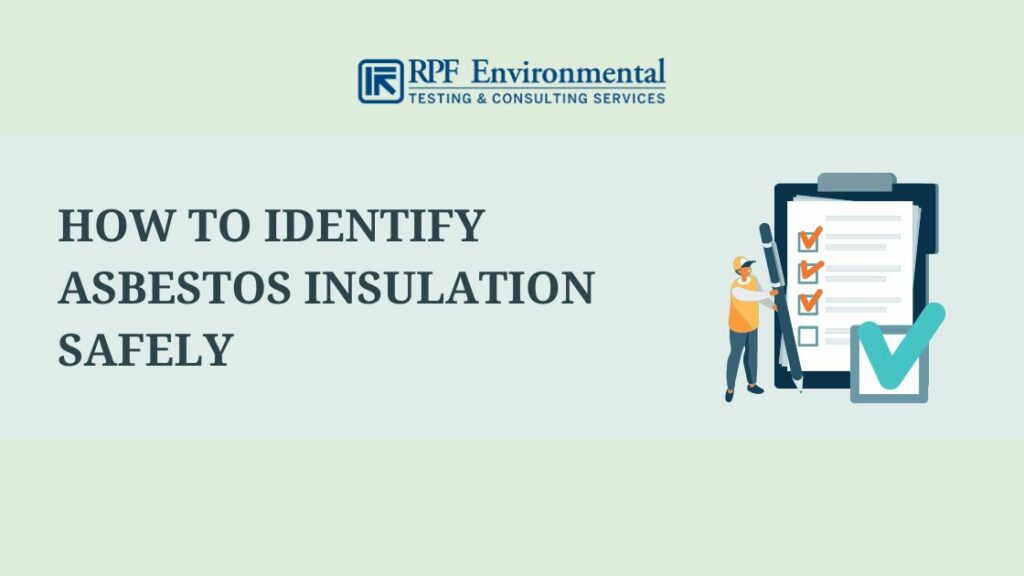
Natural asbestos consists of bundles of thin mineral fibers and can appear white, brown, blue, green, or gray when mined. But once it is manufactured with insulation materials, it’s impossible to identify it. You can only tell if the material potentially contains asbestos, but not confirm it. Visual identification won’t be enough to confirm its presence unless the product is labeled.
Moreover, there is a high possibility that you have asbestos insulation if your home was built before the 1980s. So if you suspect its presence in your home, contact a licensed and trained professional for accurate identification.
How to Identify Asbestos in Vermiculite Insulation
Unlike other types of asbestos insulation, you can often identify vermiculite insulation by sight. It’s a pebble-like material and looks like rocky gravel that can come in silvery gray, silvery gold or gray-brown colors. It can also have accordion-like particles and/or shiny flakes. Furthermore, you can check the brand name (typically Zonolite) on the material.
“You should assume that vermiculite insulation is from Libby and treat the material as if it contained asbestos by not disturbing it or by using a trained professional if it needs to be removed.” – EPA
Also Read:
Dangers & Health Risks of Asbestos Exposure From Insulation
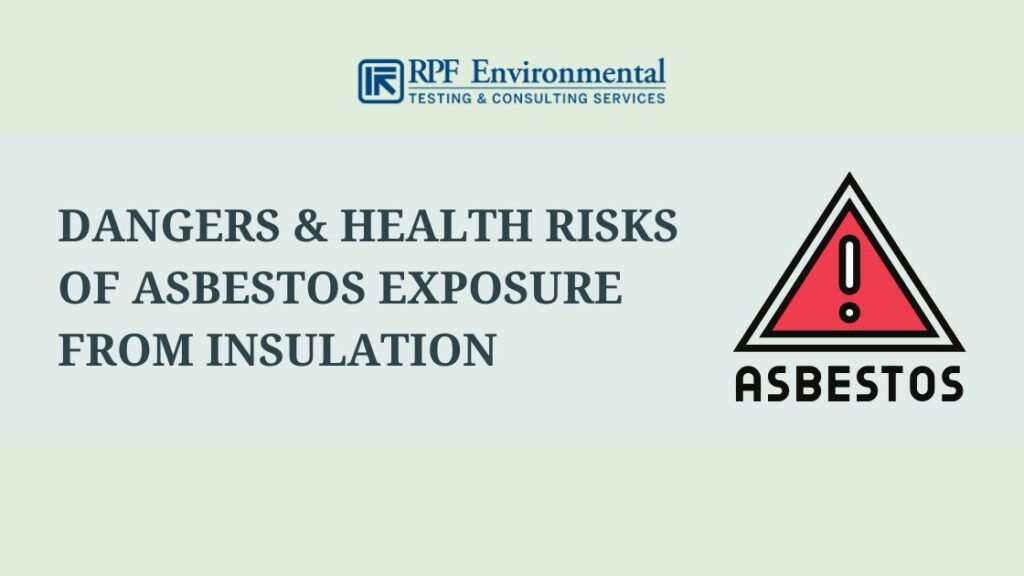
According to EPA, there is no known safe level of asbestos exposure. Asbestos insulation can pose a risk when damaged, disturbed, or removed during repairs and renovations where asbestos fibers can become airborne. Occupants in the residence and nearby areas can inhale the toxic fibers and may develop deadly cancers among other diseases in the long run.
Also, the disease may only manifest years after the exposure often when it has already become incurable. Exposure to asbestos insulation can cause:
- Asbestosis
- Mesothelioma
- Lung cancer
- Ovarian cancer
- Laryngeal cancer
- Pleural effusion
- Pleural plaques
- Pleural thickening
Who Is at Risk?
People working with asbestos insulation have the highest risk of developing asbestos diseases. These include:
- Renovation & demolition contractors
- Electricians
- Plumbers
- Carpenters
- Home inspectors
- Real estate agents
- Firefighters
- Industrial workers
In addition, families and employees in old homes and commercial buildings can also be affected when the asbestos insulation is disturbed during maintenance and renovation activities. Even insulation in old school buildings can endanger students and teachers.
NOTE: The risk of asbestos disease is increased for individuals who smoke and are exposed to asbestos insulation frequently.
Asbestos Insulation Testing & Inspection for Your Property
Since no level of asbestos exposure is considered safe, you should contact a professional to inspect your home or business if you suspect that it has asbestos insulation. Reasons and signs that you need to have your home/business tested for asbestos include:
- The Environmental Protection Agency has put efforts into regulating the use of asbestos but it is still not completely banned in the US. So if you have an old home built before the 1980s, the chances of asbestos insulation being present in it is higher.
- There is no federal law requiring property owners or sellers to disclose the presence of asbestos insulation and other asbestos materials. Consider asbestos testing first before buying a house.
- Testing for asbestos is strongly recommended when you find worn-down and damaged products suspected to contain asbestos including insulation.
Handling and Removing Asbestos Insulation: What to Do if Asbestos Insulation is Found
If you want to remove asbestos insulation in your home, hire a certified asbestos abatement company. You shouldn’t attempt DIY removal because you might end up exposing your family and nearby residents. Asbestos materials are highly friable and can easily become airborne when not handled properly. Also, you could face costly penalties and fines if you don’t hire a professional company to remove asbestos insulation safely and properly.
Safe Practices & Precautions When Handling Asbestos Insulation
You can look for signs of damage in asbestos materials in your home yourself but never touch or disturb them. Also, make sure to wear protective equipment including goggles and a mask. Leave the rest of the testing and removal activities to the professionals. Moreover, you should limit your access to the contaminated area.
FAQs
Some spray-on, loose-fill, wrapped, and block insulation materials may contain asbestos. Specific brands, like Zonolite, also contain asbestos.
You can’t confirm that an insulation material does contain asbestos because this can only be done through sample collection and laboratory analysis by a professional. But, below are some signs that the insulation may contain asbestos according to the type of insulation:
1. Spray-On Asbestos Insulation – Typically thick gray coating found on ceilings
2. Loose-Fill Asbestos Insulation – Loose, fluffy, and lumpy look with a granular texture
3. Blanket/Wrapped Asbestos Insulation – A flexible air-cell insulation that comes in large rolls or batts
4. Asbestos Block Insulation – Rigid insulation blocks that look like boards
If the asbestos insulation is in good condition and left undisturbed, it won’t pose a significant risk to the health.
Asbestos insulation can come in gray-brown, silvery gray, or silvery gold colors. However, take note that only professional testing can confirm the presence of asbestos in your home/business.
Conclusion
If you suspect asbestos insulation in your home/business, never try to handle or remove it yourself. Also, assume that old insulation, especially vermiculate, contains asbestos and you should hire a licensed asbestos testing and abatement company to deal with it.
RPF Environmental has been a leading asbestos survey and testing company in Maine, Massachusetts, New Hampshire, and throughout the US since 1991. Book an appointment now and let our certified professionals help you!

